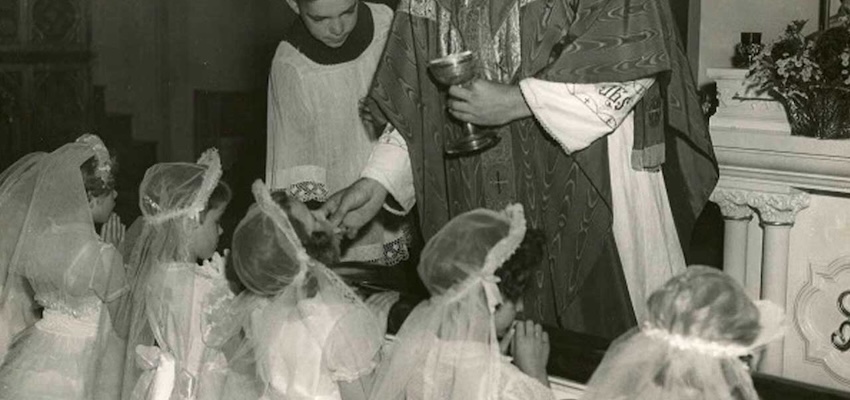
Until a few weeks ago, students attending Mass in the chapel of Charlotte Catholic High School in North Carolina received the Eucharist at an altar rail installed in 2017 using money raised by a teacher in memory of his late brother. But now priests have been ordered to leave the sanctuary during Communion. If children wish to receive the sacrament in the traditional manner, they must kneel on the floor.
The order came from the bishop of Charlotte, Michael Martin, a Birkenstock-wearing Franciscan who took office last year. He announced in May that the Traditional Latin Mass would be restricted from the four diocesan parishes that celebrated it; instead, the Mass would be offered in a single chapel north of Charlotte, adding hours to the journeys of many faithful who had the temerity to favor the usus antiquior.
Masses at Charlotte Catholic High School use the modern missal, however. Whereas Martin’s edict was in line with Traditionis Custodes, the ban on the use of the school’s altar rails belongs to his personal smorgasbord of prejudices.
The bishop has a list of things he is itching to outlaw. In addition to kneeling for communion, it includes ad orientem worship, Roman chasubles, Latin motets, and candlesticks on the altar. The priest must not use a missal stand, while the faithful must refrain from such pious exclamations as “My Lord and my God” after the consecration.
Recently, I was talking to a U.S. traditionalist who, like me, was a teenager during the late 1970s. “Do you remember the young, mean priests who stamped out old-fashioned piety with such relish?” he asked. “Well, they’re now bishops.” The folksy-but-tyrannical Martin is an extreme example of the breed and, born in 1961, perhaps represents the tail end of the cohort. Unfortunately, it is still comfortably situated in American and European dioceses, as well as the Vatican. And, unlike a previous generation of authoritarian reformers who were confident that the Latin Mass would die before they did, today’s old, mean liberals face a formidable obstacle: the revival of traditional worship by youthful Catholic priests and—an unthinkable prospect before the twenty-first century—lay teenagers.
Back in June, the spirituality of one devout fifteen-year-old was viciously attacked by the lay Italian liturgist Andrea Grillo, a professor of sacramental theology at the Pontifical Athenaeum of St. Anselm in Rome and a former adviser to Pope Francis. Grillo, an implacable enemy of the Tridentine Mass, is often described as “the mind behind” Traditionis Custodes. Yet, the teenage boy who was the subject of his scorn was not a devotee of the Latin Mass; he was St. Carlo Acutis, who died in 2006, the year before Benedict XVI liberated the ancient form of the Roman rite.
Professor Grillo therefore did not have the 1962 Missal in mind when, writing in the journal Munera, he accused the recently canonized Acutis of communicating “a Eucharistic theology so old, so heavy, so obsessive, so focused on the inessential” and of suffering from “a distorted fixation on Eucharistic miracles.” It goes without saying that Grillo was horrified by the spectacle of nineteen thousand young people walking from Paris to Chartres on a Tridentine pilgrimage last Pentecost. But his philippic against Acutis made clear that, for Bergoglian fundamentalists, the associated phenomenon of Eucharistic adoration, as popular in many Novus Ordo parishes as in Latin Mass communities, is a manifestation of “the wrong sort of spirituality”—one that, as recently as thirty years ago, was assumed to have no appeal for the young.
The adoption of traditional theology and worship by a new generation has been observed in Anglican and Eastern Orthodox communities as well as in the Catholic Church. But it is hard to grasp the implications of this “recovery of the sacred” for the future of orthodox Christianity. We should be wary of glib assertions in the media that Gen Z is turning to religion on the basis of scattered evidence, none of which is as robust as the finding that Western populations generally have stopped going to church. On the other hand, the more than nineteen thousand pilgrims who converged on Chartres for a Latin Mass were not a mirage. The phenomenon is real and cries out for deeper study. For example, is there a comparison to be drawn with the growth of fundamentalist orthopraxy among young Jews and Muslims?
What is beyond dispute, and should incline us to think more seriously about the recovery of the sacred, is the panic that has led Bishop Martin to micromanage the placement of kneelers in a high school and Professor Grillo to sneer at the first Millennial saint. Both men, it should be said, have embarrassed their allies by attracting unwelcome media attention. But their consternation is widely shared among hardline liberals, who are in a state of heightened anxiety because they do not know how much influence they will wield in the Church under Pope Leo XIV. Given the opportunity, they will lash out. To employ a cliché that seems appropriate in an era of competing forms of the Roman rite, Martin and Grillo have said the quiet part out loud.
